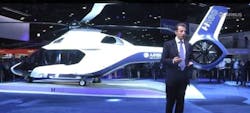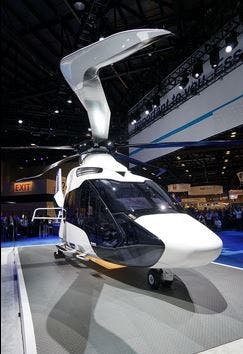Airbus Helicopters unveils all-new H160 medium-class rotorcraft, formerly called X4
ORLANDO, Fla., 3 March 2015. Airbus Helicopters at HAI Heli-Expo 2015 today revealed its all-new H160 medium-class rotorcraft – the first product introduced under the transformed Airbus Helicopters corporate identity. The 5.5-6-ton-class, twin-engine H160 rotorcraft integrates up to 68 different Airbus Helicopters-patented technologies.
Its payload lift, range, and efficiency make this helicopter well suited to a variety of uses, including oil and gas operations; public services, air medical, and coast guard duties; commercial transport, and private and business aviation, officials say.
With a cruise speed of 160 kts., the H160 can carry 12 passengers at distances of up to 120 NM. for oil and gas missions, and a 450-NM range with 20-minute reserve in public service or search and rescue tasks.
The H160 includes two Airbus Helicopter firsts, offering improved performance and flight stability: the largest-ever Fenestron shrouded tail rotor, which is also double-canted at 12-degree angles, enhancing anti-torque control efficiency; and the all-new Biplane Stabilizer, with a staggered placement of the dual-level, interconnected stabilizers to facilitate pilot maneuvers and reduce aerodynamic penalties in low-speed flight and hover.
The H160 also boasts the initial production use of Airbus Helicopters’ Blue Edge main rotor blades, which reduce exterior noise levels by 50 percent (3 dB) and allow a payload increase of up to 100 kilograms when compared to traditional rotor blades, depending on flight conditions.
The H160 is the first-ever, fully composite civil helicopter, officials say, resulting in an airframe that is lighter in weight, more robust, resistant to corrosion and fatigue, as well as requiring less maintenance. Airbus Helicopters’ Spheriflex bearingless main rotor hub is enhanced with the application of composite thermoplastic technology – which reduces weight and increases damage tolerance.
The H160 integrates Airbus Helicopters’ Helionix avionics, designed to deliver increased safety through reduced pilot workload, enhanced situational awareness, improved flight envelope protection, and system redundancy. In service today on the EC175 and EC145 T2, Helionix is an avionics family concept that enables software improvements to be integrated and retrofitted on the H160 as well as other helicopters in the company’s current, future, and evolved product lines, officials say.
To power its H160, Airbus Helicopters officials selected the new Turbomeca 1,100-shp. Arrano engine, which offers reductions in fuel consumption for improved range and payload performance, and a reduced environmental footprint. An optimized maintenance concept designed to decrease the need for on-site servicing will contribute to lower operational costs for the helicopter.
Additional features of the H160 include: electric landing gear, requiring less maintenance while also allowing more payload to be carried; easy access to various maintenance areas, which was taken into consideration during the concurrent engineering process; and flexibility in the maintenance plan to match operators’ needs and constraints thanks to MSG-3 (Maintenance Steering Group-3) inspection methodology.
“The H160 represents Airbus Helicopters’ strategy to provide the most efficient solutions for our customers, who serve, protect, save lives, and safely carry passengers in the most demanding environments,” President Guillaume Faury affirms. “We are driven by this mission, because what is important to our customers is essential to us.’”
Development of the H160 began in 2013, with the definition of the final aircraft configuration confirmed this year. The helicopter’s first flight will take place in 2015 and service entry is planned for 2018.



